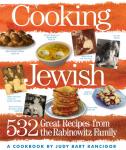
BUY COOKING JEWISH by clicking here now.
Designer kosher
Book presents Jewish holidays as if each were a
party in a decked-out Manhattan apartment.
Thursday, December 18, 2003
By JUDY BART KANCIGOR
Special to the Register
Not so long ago, the words "kosher wine" brought to mind
that syrupy sweet, almost- cough-medicine-like concoction
served as an accompaniment to prayers. Not anymore. Twenty
years ago, observant Jewish baby boomers, hipper and more
sophisticated than their parents, demanded the same selection
and quality found in the nonkosher world, and winemakers took
notice.
"Kosher wines have exploded onto the market," said Susie
Fishbein, author of "Kosher by Design" (Mesorah Publications,
$32.99), who set off an explosion of sorts herself, selling
20,000 copies of her cookbook in the first week of
publication. "There are award-winning wines from all over the
world. It's no longer Malaga and blackberry syrup."
Fishbein's book captures the beauty of the holidays with a
feast for the eye as well as the palate. With 120 lavish
photos, each holiday is presented as if it were a party. To
achieve this effect, Fishbein enlisted the help of party
planner Renee Erreich, and the luscious table settings and
presentation ideas the two created - and photographer John
Uher shot – fairly leap off the page. Set in spectacular
Manhattan apartments, the dazzling photos inspire rather than
intimidate. These are very showy menus, but everything in the
book is doable.
"The recipes and serving ideas require a minimum of fuss to
achieve the maximum esthetic impact," the author said. Unique
and exciting presentation ideas, like edible individual
challah (egg bread) napkin rings and elevated placemats
created from wrapped Hanukkah gift boxes make the book not
only a delight to cook from this Hanukkah season, but a
wonderful gift as well.
"I really felt this was a book about entertaining and
celebrating, so after considering what to serve and how to
present it, my next thought was what are the appropriate
wines. I've been so impressed with what I've been reading
recently about how kosher wines are winning awards, not just
in the kosher world, but in the real world. That's how the
idea came to include wines."
For wine-pairing ideas Fishbein consulted Miriam
Morgenstern-Laufer, an orthodox Jew and self-declared "kosher
wine guru" with an advanced degree in wine, who by day works
for Wine Spectator magazine on the business side as an
associate publisher.
"There is no difference today in quality between kosher and
nonkosher wines," Morgenstern-Laufer said. "We have great
kosher wines from just about every wine-making region of the
world - even Hungary, Bulgaria, South Africa, Australia – and
from very renowned vineyards in the nonkosher world."
What makes a wine kosher is the use of certified kosher
yeast and filtering agents, the exclusive use of equipment
under rabbinical supervision, and its handling by
Sabbath-observant Jews from the crush to the bottle. Flash
pasteurization renders some kosher wine "mevushal" with no
sacrifice in quality or flavor. Mevushal wines may then be
handled by anyone.
"Royal Wine Co., the largest importer, distributor and
owner of kosher vineyards in the world, has worked with
companies to get kosher versions into the country, even rare
kosher Bordeaux," Morgenstern-Laufer said. "They work with
beautiful chateaux to create separate areas to produce kosher
wines. There is every reason to believe that if there's a
great winery that's not kosher, they can produce a kosher wine
of equal quality."
Who is buying kosher wine? Not just observant Jews, but
millions of others who associate the word kosher with purity
and higher standards. And the choices are endless. In fact,
last Passover, Wine Spectator ranked 23 kosher wines with an
80 or above. Nicolas Feuillatte Brut Champagne from France, at
$40 a bottle, garnered an 88.
"Wine Spectator is the most-respected wine magazine in the
world because they rate very critically," Morgenstern-Laufer
said. "An 88 from Wine Spectator is like a 95 from someone
else, or a 92." In addition, she added, kosher wines from
companies like Hagafen, Baron Herzog and Weinstock Cellars are
consistently winning gold medals. "We are missing only a very
few categories. What I'm waiting for is a kosher wine from
Oregon, preferably a Pinot Noir. I'm sure somebody is working
on it. I'm confident."
Because kosher wines are virtually indistinguishable from
their nonkosher counterparts, Morgenstern-Laufer said, the
same rules apply to pairing wine with food. "You match the
weight of the wine with the weight of the food; lighter wines
with more-delicate dishes, and richer wines with more
medium-weight dishes. You don't want the wine to overwhelm the
food, and you don't want the food to overwhelm the wine.
"The challenge with 'Kosher by Design' was that these were
holiday menus, feasts really, so I chose wines to match the
feast. Some of the sauces were richer, had some fruit, like
figs or blackberries. I needed to pair the wines to match the
richness or fruitiness in the sauces."
For a chicken dish in blackberry sauce, for example, she
recommended fruity merlots by Herzog and Benyamina to pick up
the berry and fruit flavors in the sauce. A spicy Asian steak
salad called for Arabanel Gewurztraminer. "As a general rule,
highly spiced foods don't necessarily go great with wine
unless there's a touch of sweetness to the wine, so I
recommended a number of off-dries to counter the sweetness in
the sauces. The spicier the dish, the fruitier and less-dry
the wine should be." For the book's Hanukkah menu,
Morgenstern-Laufer looked for a crisp wine to cut through the
oiliness and then based her choice on the regional nature of
the dishes. "The menu has Italian leanings, so I chose an
Italian red wine with good acid to cut through the cheese and
oil. It goes well with the potato latkes (pancakes), too,
which are a little bit greasy and crisp. The creaminess of the
cheese tones down the acid of the wine, the tannin that makes
your mouth pucker, so they compliment each other. That's why
people drink red wine with cheese. A Côtes du Rhône would be
good, or a Chianti."
The menu selections Fishbein chose for the holidays are as
well thought out as the wine choices. "It's not like we
thought, 'We need a soup, let's put one here.' Food is so much
a part of the Jewish holidays that it enriches the experience
to tie the food into the holiday traditions," she said. To
accomplish this Fishbein goes way beyond "It's Hanukkah. Let's
have latkes."
"The whole thought process behind this book was instead of
using traditional holiday foods – and so many cookbooks do
that very, very well – I wanted to look at the traditional
meaning behind those foods and how I could express that
meaning with a modern twist.
"For example, why do we eat potato latkes on Hanukkah?
There is nothing holy about potatoes. It's almost sad that the
potato has become an icon of Hanukkah. The holiday is about
the oil, not the potato."
So why not fry eggplant? Fishbein's Hanukkah menu includes
Rigatoni à la Norma featuring fried eggplant as well as the
requisite potato latkes. God "didn't command us to eat
rigatoni, but he didn't tell us to eat potato latkes, either.
Although any recipe can be for any occasion, we can use a
particular dish as a teachable moment, a reason to say to our
kids" – and Fishbein has four under the age of 9 - " 'You know
why we're eating fried eggplant, you guys? It's to celebrate
the miracle of the oil.' "
That miracle, of course, is the story of Judah and the
Maccabees, who in 165 B.C. defeated the Greek army against
great odds. Wishing to rededicate the Temple, they found only
enough oil to last one day. By a great miracle, the oil lasted
eight days, and Jews the world over have been frying food in
oil for Hanukkah ever since.
"In Israel, the Hanukkah miracle is celebrated by eating
sufganiyot (jelly doughnuts)," Fishbein said. "Now,
there's nothing holy about jelly doughnuts, so I thought, why
not banana beignets. Maybe it's not my grandmother's Hanukkah
menu, but it's incredibly appropriate."
A lesser-known Hanukkah tradition involves the story of
Judith, a beautiful widow who invited the enemy general
Holofernes to dine with her. She plied him with cheese to make
him thirsty for wine, and when he fell into a drunken stupor,
she beheaded him. Because her bravery is said to have inspired
the Maccabees, Jews remember Judith by eating cheese during
Hanukkah.
Parmesan-crusted grouper and tiramisu cheesecake, delicious
any time of year, are therefore as fitting for Hanukkah as
latkes. "It's nice to use food as an opportunity to tell your
children the story of Hanukkah," Fishbein said. "That's what
this book does, without being overly biblical."
And pairing these holiday dishes with wines that augment
their flavors only heightens the experience,
Morgenstern-Laufer said. "The food makes the wine taste
better, and the wine makes the food taste better. For example,
why do you put lemon on fish? It's because you think the
crispness of the lemon will be a nice contrast for the
blandness of the fish. A glass of crisp, herbal Sauvignon
Blanc will accomplish the same thing."
The wines she chose for the beignets feature the Muscato
grape. "This aromatic, peachy, perfumy-like wine goes well
with the beignets, because it has just the right amount of
sweetness, but it's not cloyingly sweet, like a Sauterne would
be. An Asti Spumanti also pairs well with dessert, as does a
sweeter-style champagne."
People don't realize it, she noted, but champagne is not
just for toasting. Its crispness goes well with a variety of
food, so it's ideal for a holiday buffet. "But serve champagne
in flutes so as not to dissipate the bubbles,"
Morgenstern-Laufer advised. "Save your grandmother's coupes
for dessert."
Experimenting with wines and exposing your palate to new
combinations will enhance your holiday celebration, she said.
"In my opinion, wine is food; wine is a journey. It's a
lifelong learning process. It's all about history, geography
and taste. That's why people are passionate about it. There's
always something new to learn."

